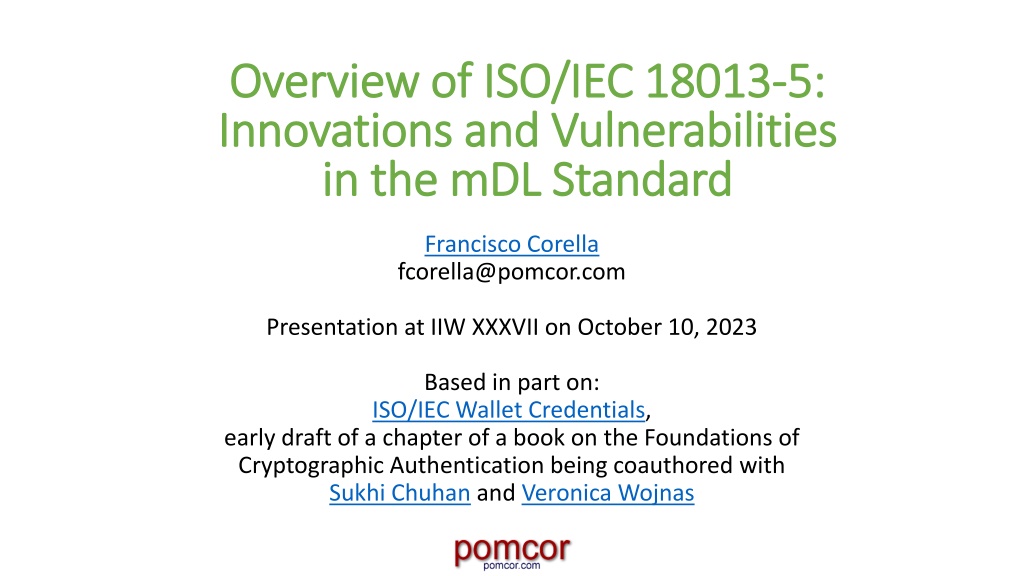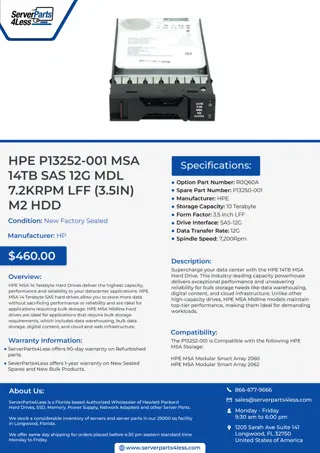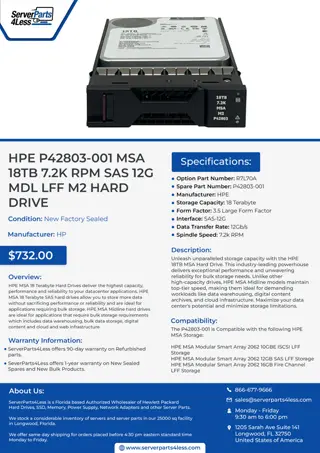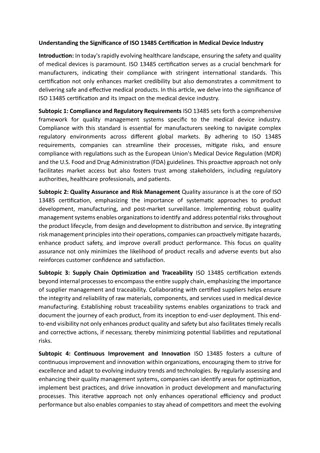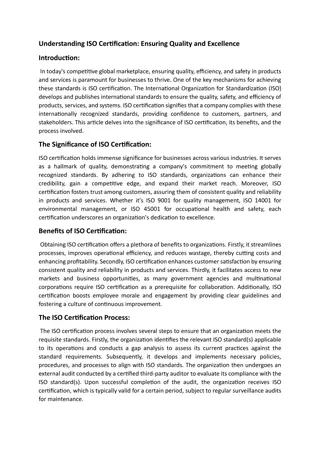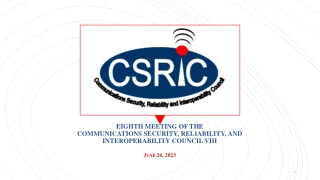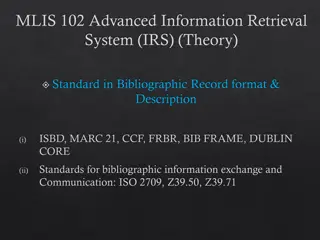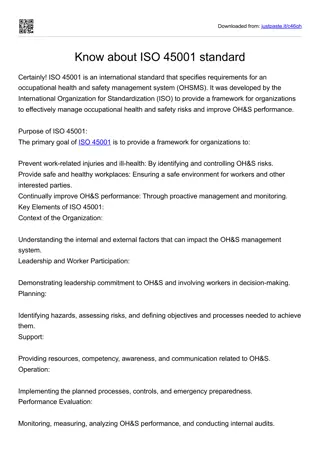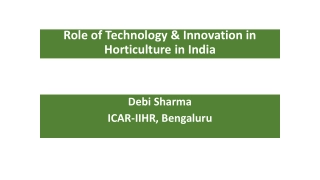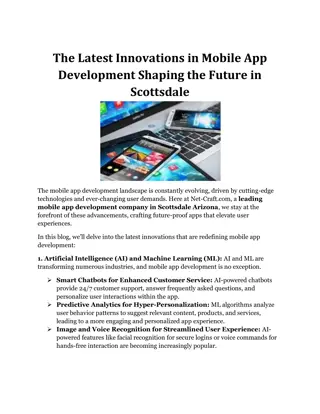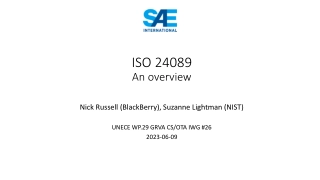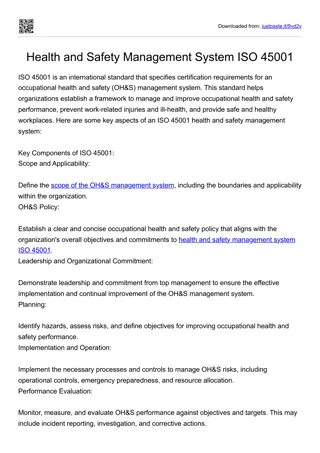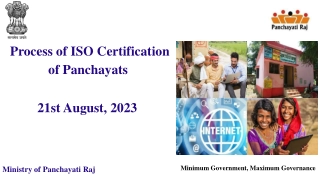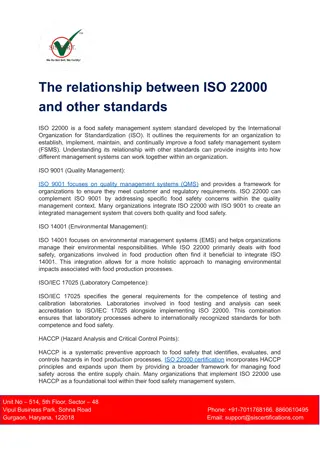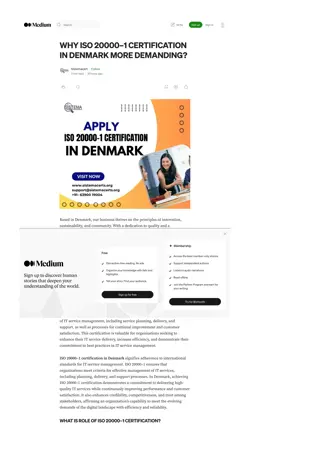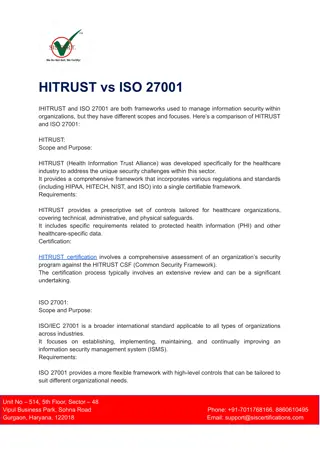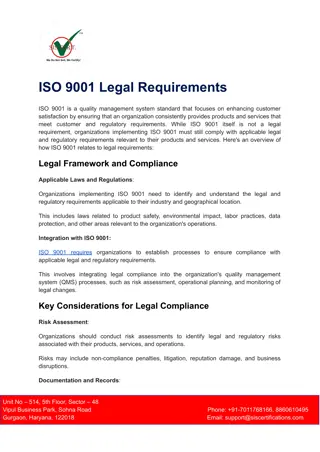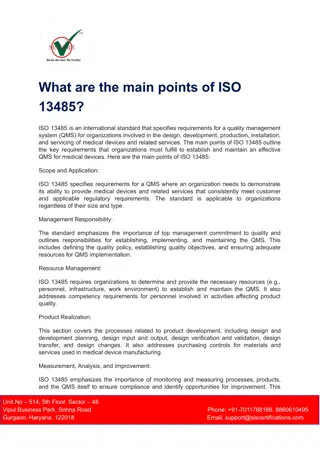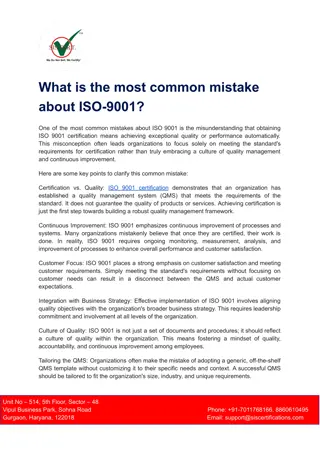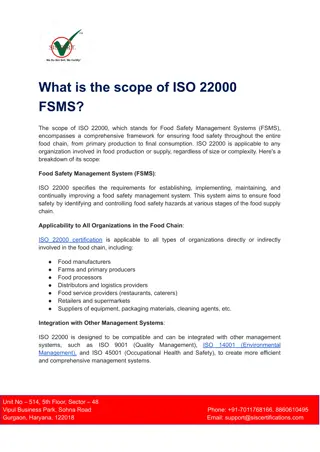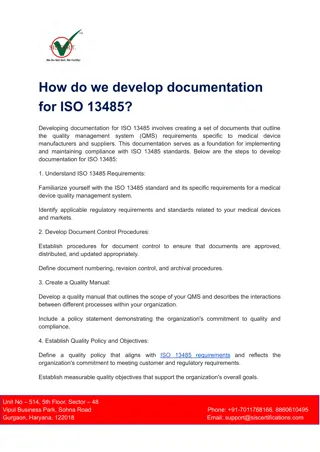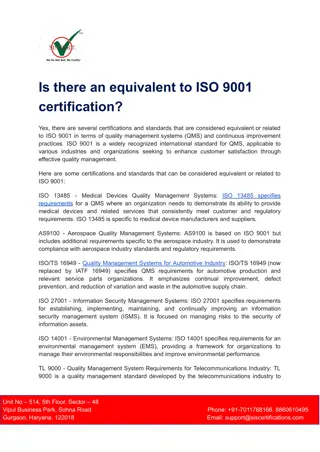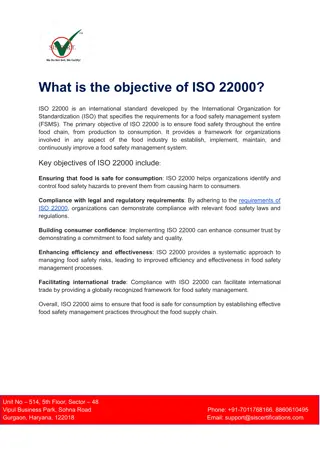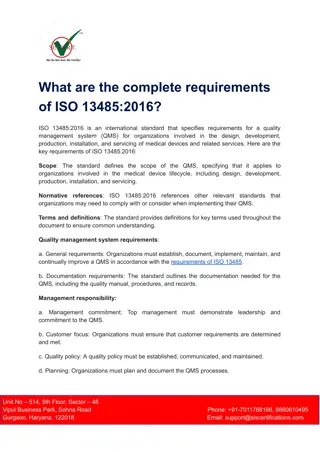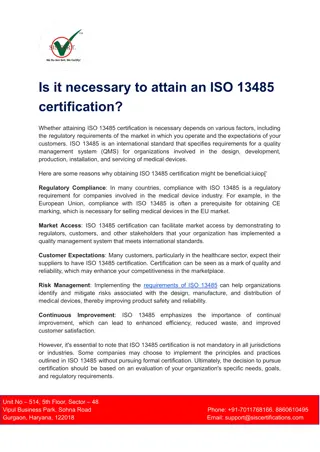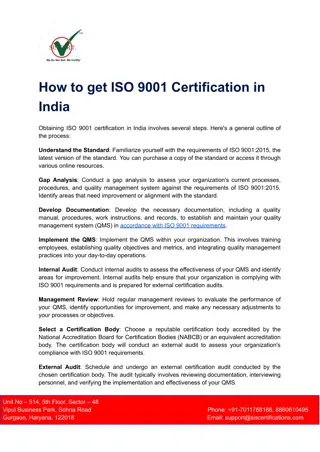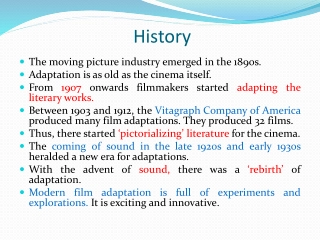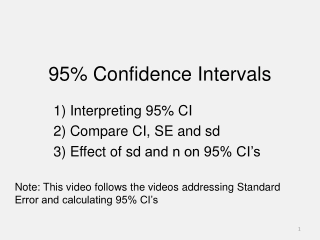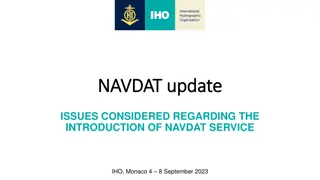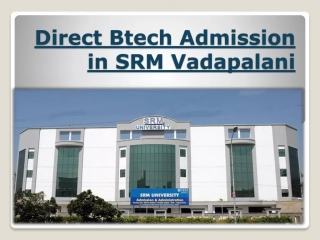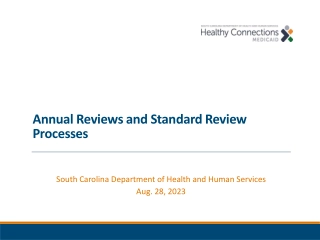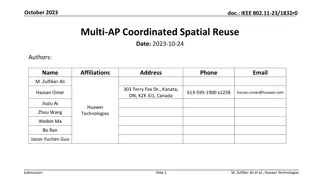Innovations and Vulnerabilities in ISO/IEC 18013 mDL Standard
Explore innovations and vulnerabilities in the ISO/IEC 18013 mDL (mobile Driver's License) standard in this presentation by Francisco Corella. Covering architecture, data elements, authentication methods, security innovations, and privacy goals, the talk delves into the nuances of mDL technology and its implications for driver's licenses carried in mobile apps.
Innovations and Vulnerabilities in ISO/IEC 18013 mDL Standard
PowerPoint presentation about 'Innovations and Vulnerabilities in ISO/IEC 18013 mDL Standard'. This presentation describes the topic on Explore innovations and vulnerabilities in the ISO/IEC 18013 mDL (mobile Driver's License) standard in this presentation by Francisco Corella. Covering architecture, data elements, authentication methods, security innovations, and privacy goals, the talk delves into the nuances of mDL technology and its implications for driver's licenses carried in mobile apps.. Download this presentation absolutely free.
Presentation Transcript
Overview of ISO/IEC 18013 Overview of ISO/IEC 18013- -5: 5: Innovations and Vulnerabilities Innovations and Vulnerabilities in the mDL Standard in the mDL Standard Francisco Corella fcorella@pomcor.com Presentation at IIW XXXVII on October 10, 2023 Based in part on: ISO/IEC Wallet Credentials, early draft of a chapter of a book on the Foundations of Cryptographic Authentication being coauthored with Sukhi Chuhan and Veronica Wojnas
Outline Outline In a nutshell Architecture Data elements Terminology Selective disclosure Comparison to other methods Data exchange phases and flows Authentication in device retrieval Security innovations and vulnerabilities Privacy and user experience Supported and unmet privacy goals
In a nutshell In a nutshell Part 5 of ISO/IEC 18013 series of related to driver's licenses Data model of driver's license carried in a mobile app Protocol for attended presentation to a verifier equipped with a reader Reader can retrieve data from the mobile device Or get a token from the device and use it to retrieve data from the issuing authority over the internet Presentation over the internet is being specified in part 7
Architecture Architecture
Data elements Data elements Table 5 of the standard lists the data elements of a driver's license, some mandatory, some optional For example: Family and given names in ISO/IEC 8859-1 Latin No. 1 (mandatory) Family and given names in UTF-8 national characters (optional) Date of birth (mandatory) Portrait of the holder (mandatory, jpeg) Driving privileges, as defined in ISO/IEC 18013-1:2018 (mandatory) Full address (optional) Image of handwritten signature (optional)
Namespaces Namespaces A data element has an identifier that is unique within a namespace The data elements of Table 5 comprise the namespace: org.iso.18013-5.1.mDL The standard cites examples of extensions of the defined namespace: org.iso.18013-5.1.mDL.US (United States) org.iso.18013-5.1.mDL.US-IA (Iowa) But any namespace can be used => General purpose specification of mobile credentials
Terminology Terminology A credential is called a "document", or an "mdoc" An mDL is a particular kind of mdoc There can be multiple documents in an application; and in principle there could be multiple applications in a device; but typically, there will be one device, one application, and one document The term "mdoc" is used to refer to the device, the application, or the credential The reader is called the "mdoc reader"
Selective disclosure Selective disclosure A credential can have certified ("issuer-signed") and self- asserted ("device-signed") data elements Certified elements can be selectively disclosed: Issuer signs list of digests of all the certified elements Prover discloses some of them Verifier hashes the disclosed elements and verifies that their digests are in the list A random value is included in each digest to prevent guessing Mobile security object (MSO) signed by the issuer binds the mdoc pubic key to the list of digests
Comparison to other methods Comparison to other methods of selective disclosure of selective disclosure Based on hash functions Selective disclosure of JWTs (SD-JWT) Oauth working group draft-ietf-oauth-selective-disclosure-jwt-05 Merkle tree with typed nodes US patents 10,567,377 and 11,329,981; rich credentials Presented at IIW XXIII, 2016 X.509 certificate with selectively opened folders US patent 6,802,002 Presented at RSA 2000 Based on proofs of knowledge Anonymous credentials Camenisch-Lysyanskawa signatures 2002
SD SD- -JWT ( JWT (Oauth Oauth Working group) Working group) An SD-JWT is a signed JWT where selectively disclosable claims have been replaced by their digests Disclosed claims are sent to the verifier along with the SD-JWT If the SD-JWT is used for holder authentication, the holder's public key, or a reference to it, is included in the JWT => An SD-JWT is roughly equivalent to the MSO More general than mDL: SD-JWT can have hierarchy of objects and digests can be properties of objects or array elements To authenticate the holder, a separate Key Binding JWT containing a verifier nonce and signed with the holder's private key is sent to the verifier along with the SD-JWT and the disclosed claims But details are left out of scope, while specified in the mDL
Merkle tree with typed nodes Merkle tree with typed nodes Encoding of a set of name value pairs: Leaf node: type = name, label = value Internal node: type = distinguished, label = hash of types and labels of its children Selective omission of name-value pairs by pruning subtrees Pruning a subtree leaves its root node as a "dangling node", which is a leaf node but doesn't encode a name value pair because it has the distinguished type The name-value pairs of the subtree are gone, but the root label of the tree doesn't change The root label of the tree is an omission-tolerant digest of the set of name-value pairs in the tree A selective disclosure certificate can be constructed by binding the omission-tolerant checksum to the subject's public key
X.509 certificate with X.509 certificate with selectively opened folders selectively opened folders Folder = structured ASN.1 field with flag indicating if it is open or closed Closing a folder = replacing its contents with a digest of its contents Folders can be nested The certificate is signed after closing all folders Selected folders are open before presentation to the verifier
Selective disclosure with Selective disclosure with anonymous credentials anonymous credentials Camenish-Lysyanskaya signature (many details omitted): ??= ????? mod ? Message: m Signature: v, e, s Public key of the signature scheme: a, b, c, n Private key of the signature scheme: the factorization n = pq Algorithm: Choose random prime e Compute v using 1/e mod (p-1)(q-1) Security based on strong RSA assumption
(Selective disclosure with anonymous credentials, continued) (Selective disclosure with anonymous credentials, continued) Commitment to a secret value ? = ?? ?mod ? Committed value: m Random witness: r Commitment: C Public key of the commitment scheme: n, g, h The user who constructs the commitment can prove knowledge of the committed value in zero knowledge
(Selective disclosure with anonymous credentials, continued) (Selective disclosure with anonymous credentials, continued) Proof of knowledge of a signature on a committed value ??= ????? mod ? ? = ?? ?mod ? A user who receives the signature and constructs the commitment can prove knowledge of v, e, s and m in zero knowledge
(Selective disclosure with anonymous credentials, continued) (Selective disclosure with anonymous credentials, continued) Proving knowledge of a signature on a block of committed values ???4 ????? mod ? ???2 ???3 ???5 ??= ?1 ??= ??? ??mod ? ??= ??? ??mod ? ??= ??? ??mod ? ??= ??? ??mod ? ??= ??? ??mod ? A user who receives the signature and constructs the commitments can prove knowledge of values v, e, s, ??,??, ??,??, and ??that satisfy the above equations in zero knowledge
(Selective disclosure with anonymous credentials, continued) (Selective disclosure with anonymous credentials, continued) Using a signature on multiple messages as a credential ???4 ????? mod ? ???2 ???3 ???5 ??= ?1 Authentication key: ?? Attributes: ??, ??,??, ??
(Selective disclosure with anonymous credentials, continued) (Selective disclosure with anonymous credentials, continued) Disclosing some of the attributes For example ?? and ??: ???4 ???3 ????? mod ? ????? mod ? ???2 ???2 ???3 ???4 ???5 ???5 ??= ?1 ??= ?1 Holder proves knowledge of values v, e, s, ??,??, and ??that satisfy the following equations in zero knowledge: ???2 ???4 ????? mod ? ???5 ????? mod ? ??= ?1 ? = ?3 , with ??= ??? ??mod ? ??= ??? ??mod ? ??= ??? ??mod ?
(Selective disclosure with anonymous credentials, continued) (Selective disclosure with anonymous credentials, continued) Authenticating with the credential and disclosing some of the attributes, for example ?? and ?? ??= ?1 = ?1 ???4 ??????3 ????? mod ? ???5 ???2 ???2 ???3 ???4 ???5 ??mod ? ???2 ???4 ?? ?mod ? ? = ?1 The credential holder proves knowledge of v, e, s, ??,??, ??,??, and ?? that satisfy the above equations in zero knowledge
Data exchange phases Data exchange phases Device activation By the holder, or By the reader using NFC Device engagement (data retrieval setup) QR code shown on the device, or NFC handover Data retrieval From the device ("device retrieval"): NFC, BLE or Wifi From the issuer ("server retrieval"): Web API, or OpenID Connect
Data exchange flows Data exchange flows QR code followed by BLE or WiFi device retrieval 1. Device activation by holder and display of QR code 2. Device retrieval using BLE or WiFi NFC handover followed by NFC, BLE or WiFi device retrieval 1. Device activation by NFC tap 2. NFC handover 3. Device retrieval, continuing with NFC or switching to BLE or WiFi Any device retrieval followed by server retrieval 1. Device retrieval provides server retrieval token as a data element 2. Server retrieval using Web API or OIDC as authorized token Any device engagement followed by server retrieval 1. Device engagement provides server retrieval token directly 2. Server retrieval using web API or OIDC as authorized by token
Authentication in device retrieval Authentication in device retrieval Device retrieval consists of requests by the mdoc reader and responses from the mdoc in an encrypted session Both parties use ephemeral key pairs to establish the session: neither party is authenticated! But the elements themselves are authenticated In each response: The MSO is sent to authenticate the disclosed certified elements The mdoc signs the self-asserted elements The mdoc signature on the self-asserted elements authenticates the mdoc If no self-asserted elements, the mdoc signs an empty list If the mdoc reader sends multiple requests, the mdoc authenticates multiple times!
Security innovations Security innovations Retrieval of self-asserted and certified data elements from the same credential ECDH-agreed MAC Unconventional use of OpenID Connect
ECDH ECDH- -agreed MAC agreed MAC In a device retrieval response, the self-asserted elements are signed with the static private key of the credential Two methods are provided for computing the signature: A traditional asymmetric signature, using ECDSA or EdDSA An "ECDH-agreed MAC" The ECDH-agreed MAC is computed in two steps: The device uses the static key pair of the credential to perform a key exchange with the same ephemeral key pair that the reader uses to establish the encrypted session The device derives a symmetric key from the resulting shared secret and uses it to compute MAC This has the privacy advantage that the MAC is repudiable, since it could have been computed by the reader
Unconventional use of OpenID Connect (OIDC) Unconventional use of OpenID Connect (OIDC) In server retrieval, the reader may use OIDC to request data elements from the issuing authority, with the reader as the relying party and the issuer as the authorization server But the holder is not involved! The OIDC user is the traffic cop! OIDC is used as follows: 1. The reader sends a request to the authorization endpoint, listing the requested data elements in the scope parameter 2. The server retrieval token is used as the "login_hint" parameter 3. The authorization server interprets the token as providing authorization, and swaps it with the authorization code without authenticating the user 4. The reader swaps the authorization code for the ID Token and finds the requested elements in its claim set
Vulnerabilities Vulnerabilities Vulnerability to man-in-the-middle attacks Unauthorized access Surreptitious activation Eavesdropping device engagement to capture the server retrieval token
Vulnerability to man Vulnerability to man- -in in- -the the- -middle attacks middle attacks Section 9.1.3.1 "The security objective of mdoc authentication is to prevent cloning of the mdoc and to mitigate man in the middle attacks." Section 9.1.3.3 "The mdoc private key, which belongs to the mdoc public key stored in the MSO, is used to authenticate the mdoc. It is also used to authenticate the response data contained in the DeviceSignedItems structure"
Attack setup??? MITM attacker ??? Device Reader Issuer-signed elements certified by MSO mdoc (i.e. credential) Device-signed elements signed by private key Private key
Attack setup Man-in-the-middle attacker Reader Device Attack reader Impersonator's device
Does this attack succeed? Man-in-the-middle attacker Reader Device Attack reader Impersonator's device Request for data elements Request for data elements Request for data elements Issuer-signed elements certified by MSO Issuer-signed elements certified by MSO Issuer-signed elements certified by MSO Device-signed elements signed by private key Device-signed elements signed by private key Device-signed elements signed by private key
Does this attack succeed? Man-in-the-middle attacker Reader Device Attack reader Impersonator's device Request for data elements Request for data elements Request for data elements Issuer-signed elements certified by MSO Issuer-signed elements certified by MSO Issuer-signed elements certified by MSO Device-signed elements signed by private key Device-signed elements signed by private key Device-signed elements signed by private key NO, because the signature also covers the ephemeral public key of the reader
Data exchange flows Data exchange flows QR code followed by BLE or WiFi device retrieval 1. Device activation by holder and display of QR code 2. Device retrieval using BLE or WiFi NFC handover followed by NFC, BLE or WiFi device retrieval 1. Device activation by NFC tap 2. NFC handover 3. Device retrieval, continuing with NFC or switching to BLE or WiFi Any device retrieval followed by server retrieval 1. Device retrieval provides server retrieval token as a data element 2. Server retrieval using Web API or OIDC as authorized token Any device engagement followed by server retrieval 1. Device engagement provides server retrieval token directly 2. Server retrieval using web API or OIDC as authorized by token
This attack succeeds Issuing Authority Request for certified elements with server retrieval token Certified elements Man-in-the-middle attacker Impersonator's device Reader Device Attack reader QR code with server retrieval token QR code with server retrieval token QR code with server retrieval token
Surreptitious activation Surreptitious activation Section 6.3.2.2: "Activation is done by the mDL holder, or triggered by an mDL reader using NFC." NOTE after 6.3.2.2: "It is important to avoid unauthorized access by an mDL reader if mDL activation is triggered by NFC." --- How? Surreptitious activation can be performed: Using a COTS reader within 10 cm of the device, in crowded public transportation Using a loop antenna built into a briefcase within 50 m: http://www.rfidblog.org.uk/hancke-rfidrelay.pdf
Eavesdropping on device engagement to Eavesdropping on device engagement to capture the server retrieval token capture the server retrieval token Device engagement data is transmitted by NFC or in the QR code and contains the server retrieval token in the clear Passive eavesdropping on NFC can be performed from a distance of several meters: D. R. Novotny, J. R. Guerrieri, M. Francis and K. Remley, "HF RFID electromagnetic emissions and performance," 2008 IEEE International Symposium on Electromagnetic Compatibility, Detroit, MI, USA, 2008, pp. 1-7, doi: 10.1109/ISEMC.2008.4652133 QR codes are designed for a 10:1 distance-to-size ratio, but the attacker could take a high-resolution photo from several meters and enlarge it before scanning it After capturing the token, the attacker has unfettered access to data elements from the issuing authority
Privacy and user experience Privacy and user experience The UI between the holder and the device and between the holder and issuance authority are out of scope ==> Many aspects of privacy and UX are left to be designed by particular jurisdictions Annex E makes privacy recommendations to be implemented by those jurisdictions Some recommendations are supported but some are hindered by the standard
Supported recommendations Supported recommendations Data minimization Supported by selective disclosure and age attestations Declaration and authorization of intent to retain elements
Hindered recommendations Hindered recommendations Informed consent Hindered by the following statement in Section 7.2.1: "An mDL shall not require mdoc reader authentication as a precondition for the release of any of the mandatory data elements" Unlinkability Partially supported by rotation of the mdoc key pair Rotation fails to prevent linkability by readers in collusion with the issuer; full unlikability requires zero-knowledge technology
